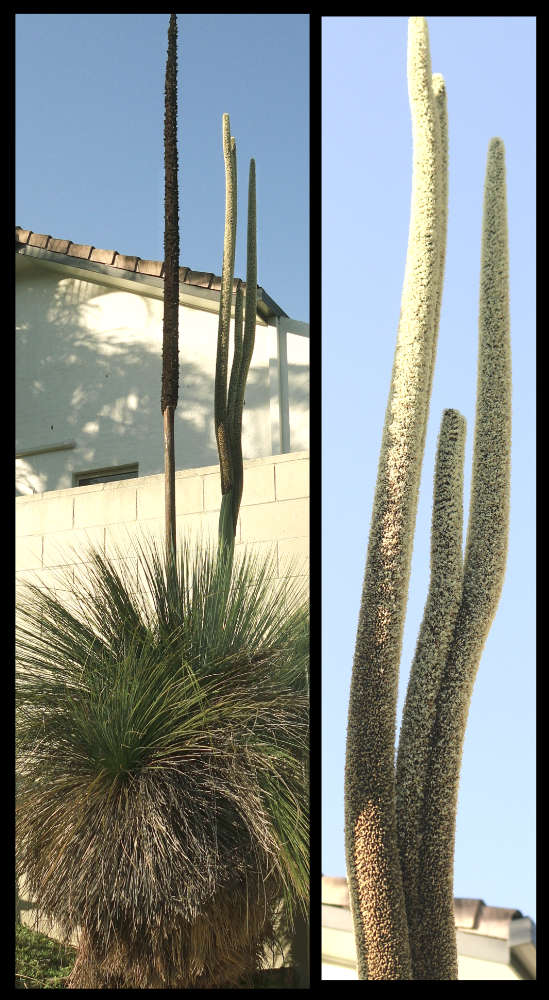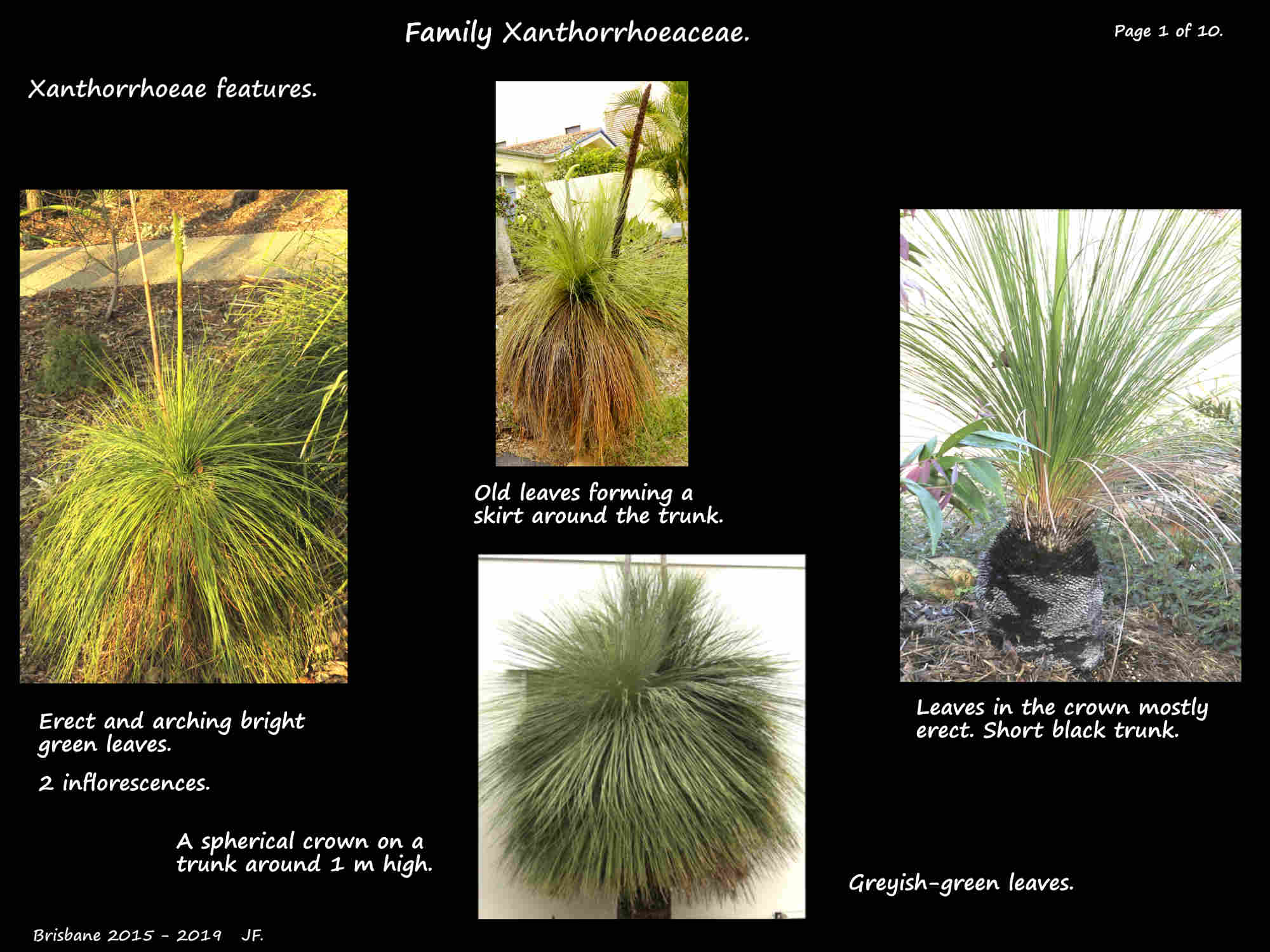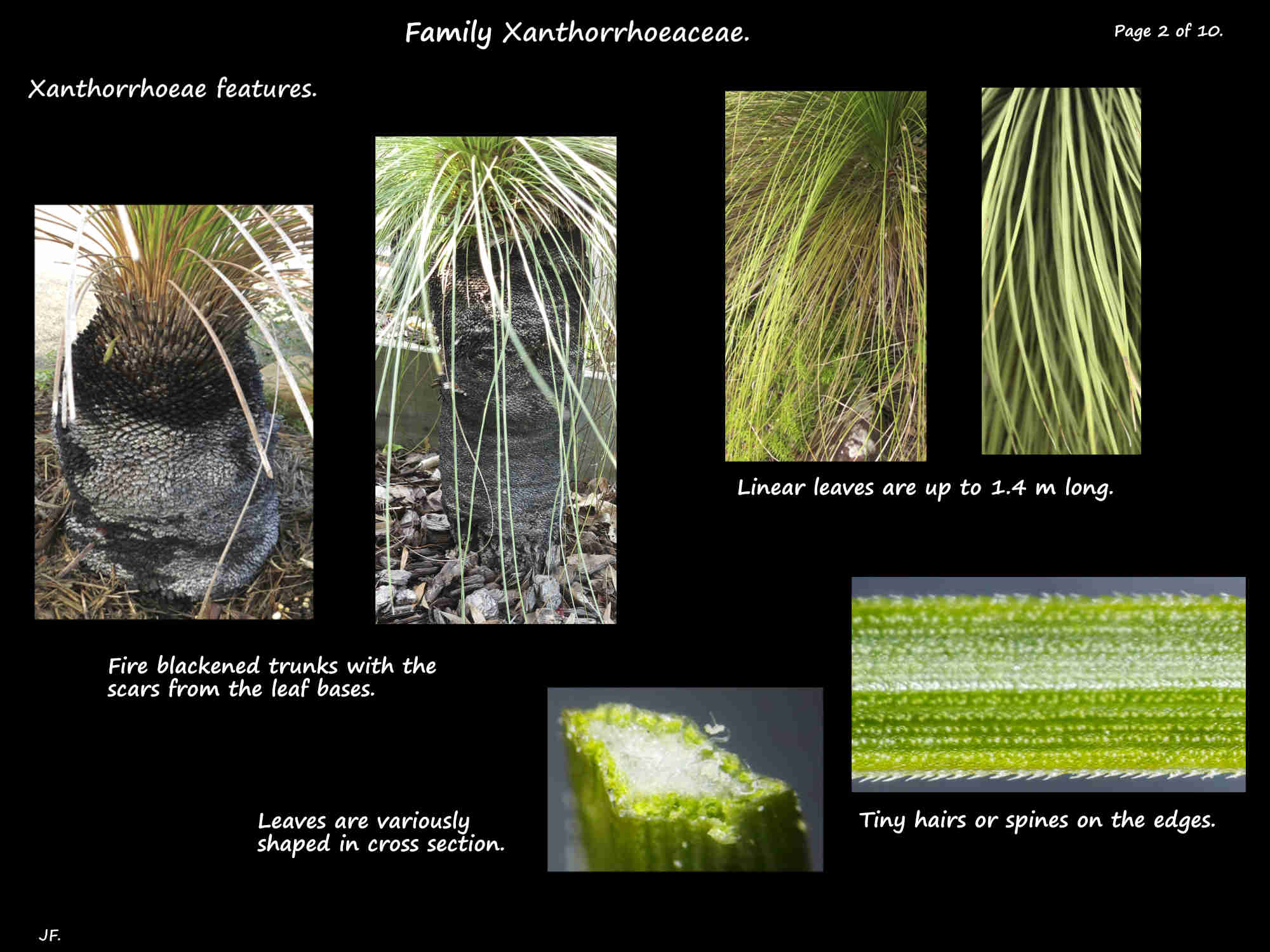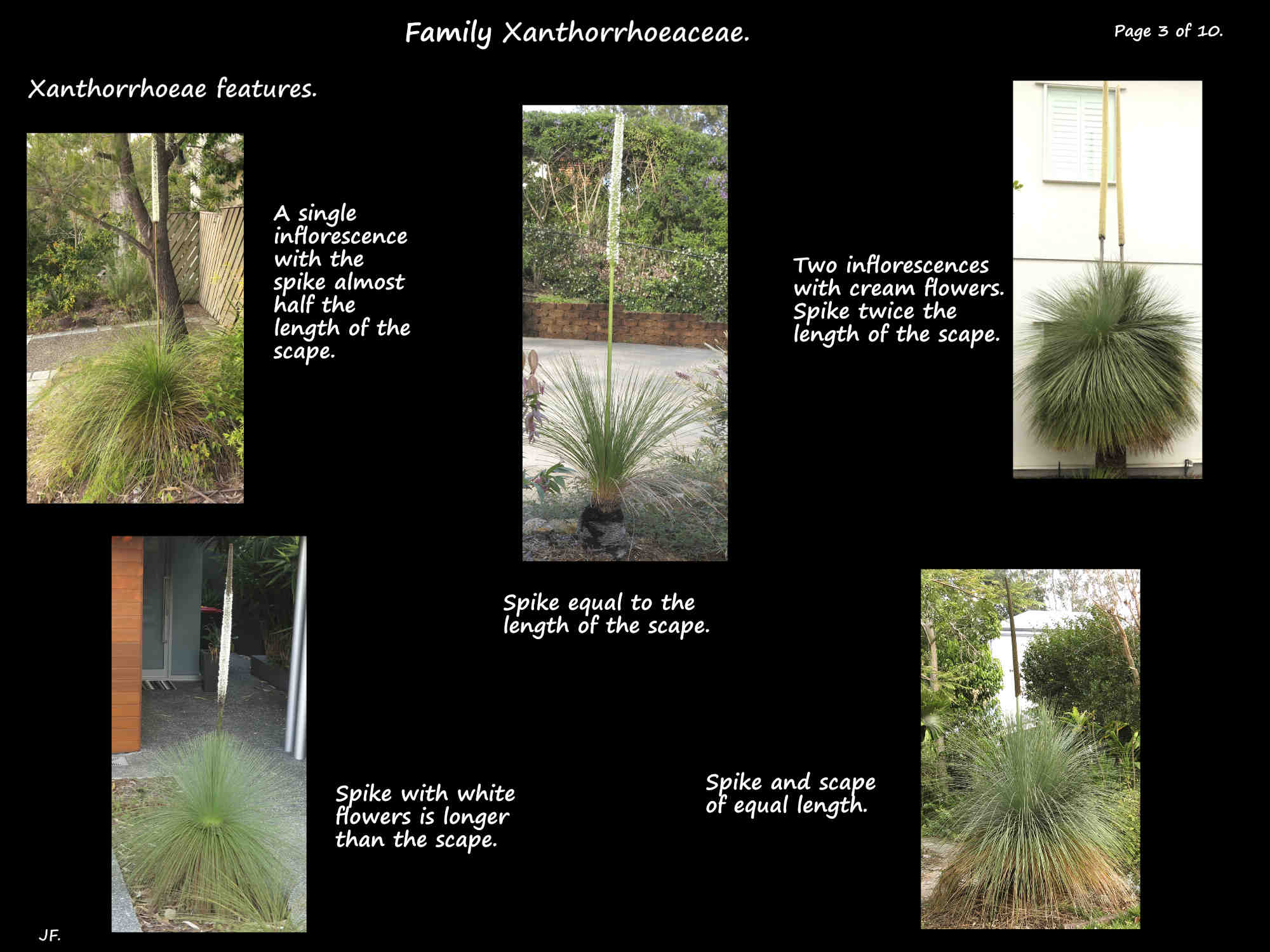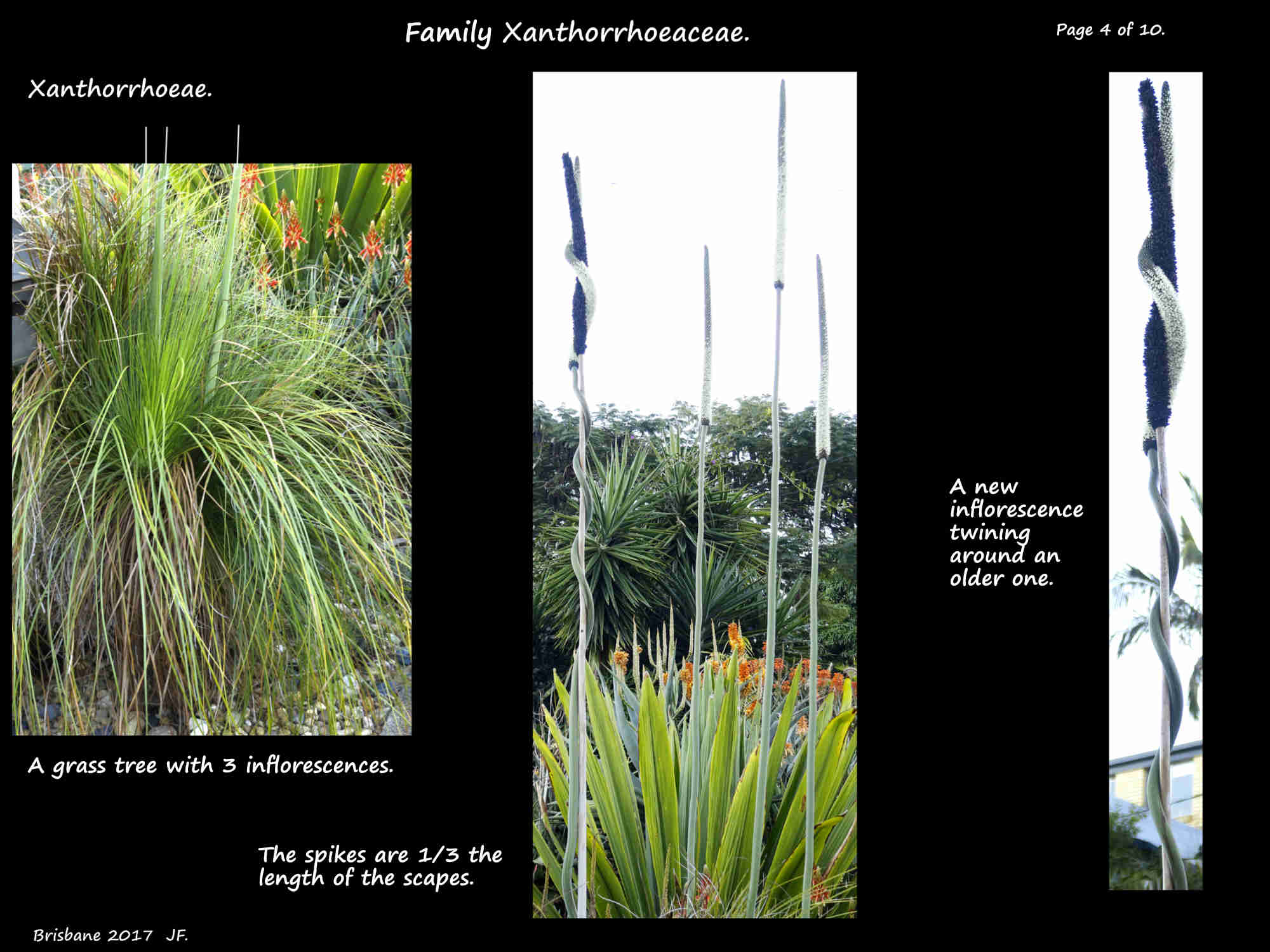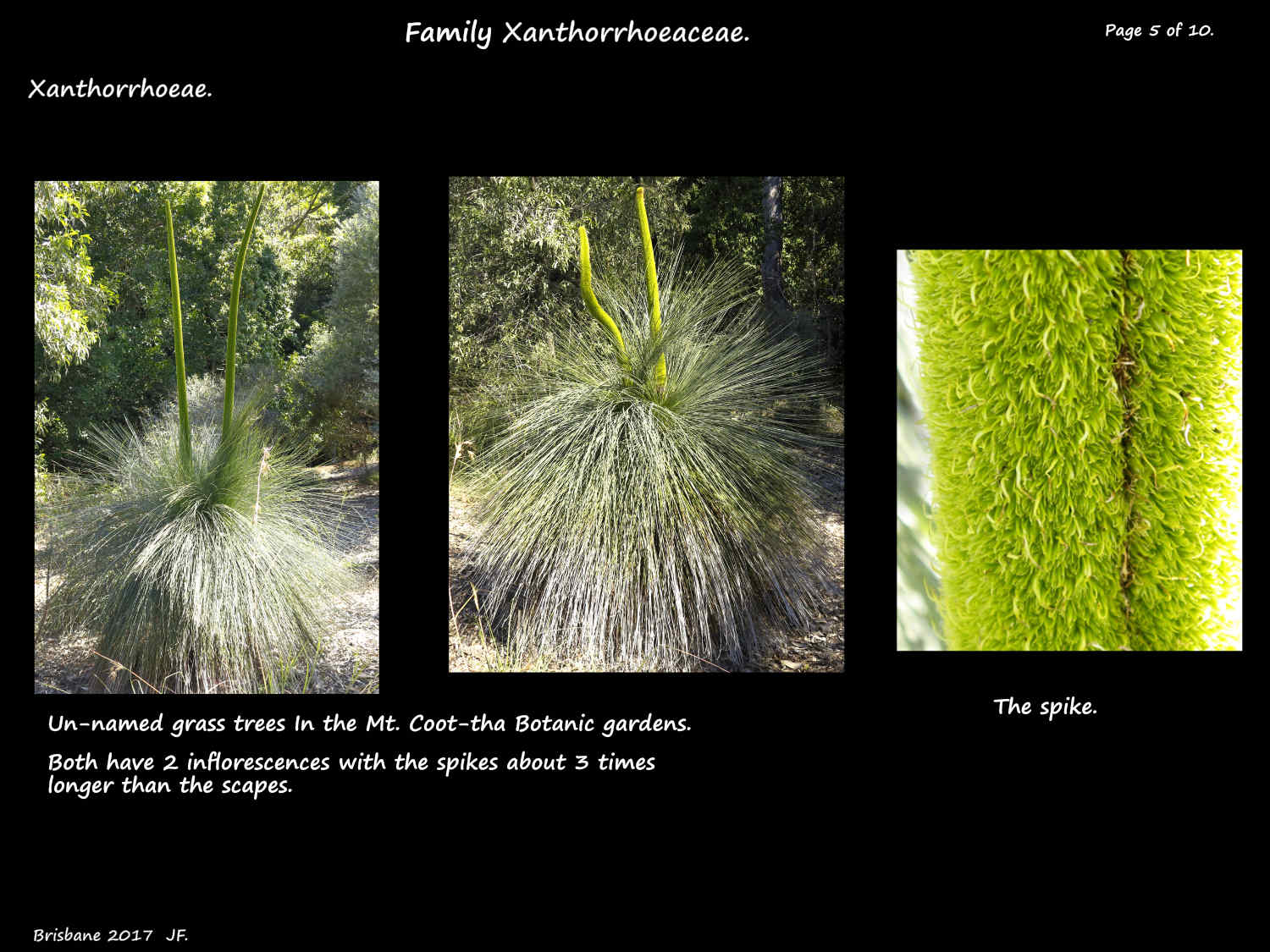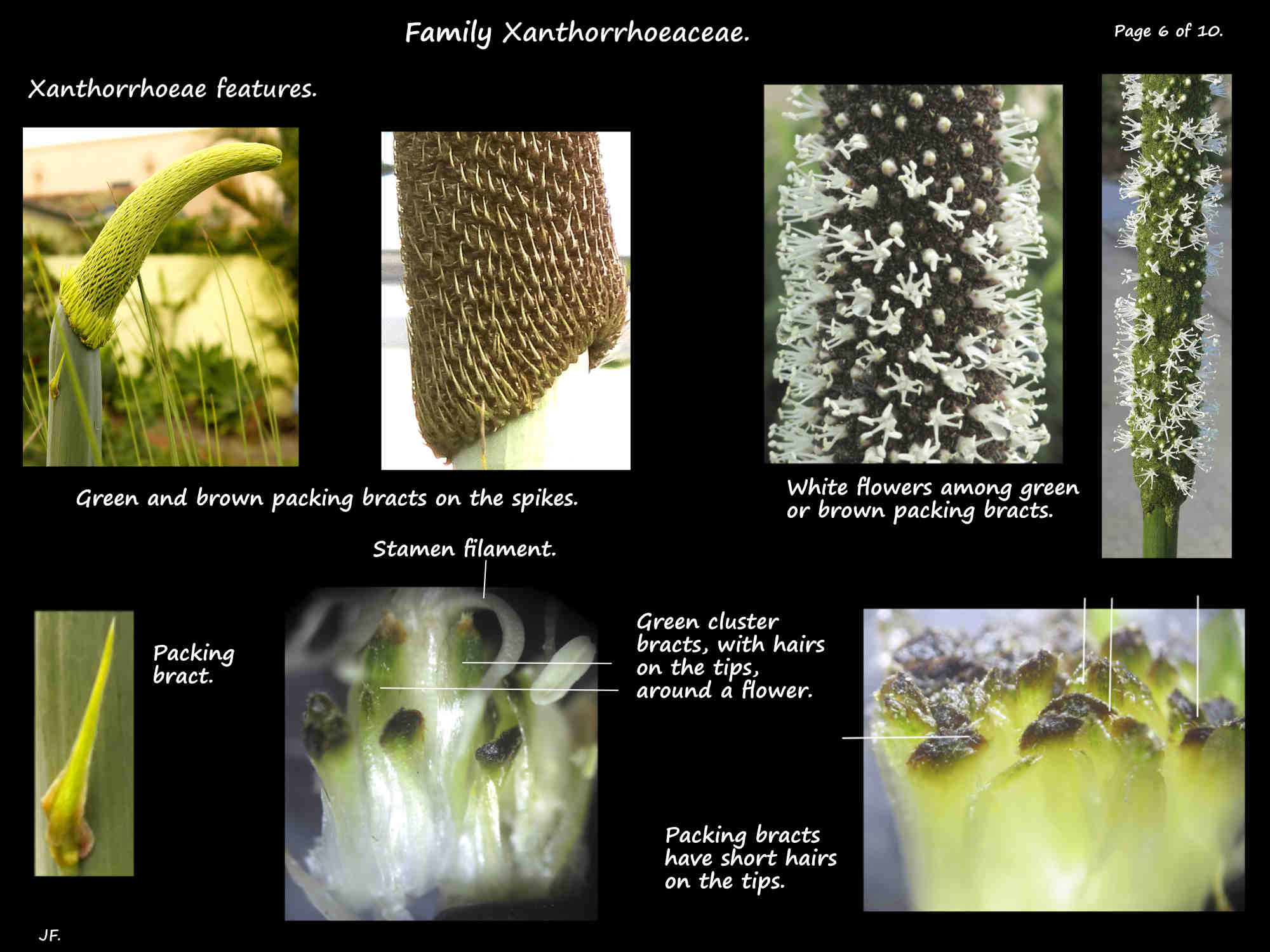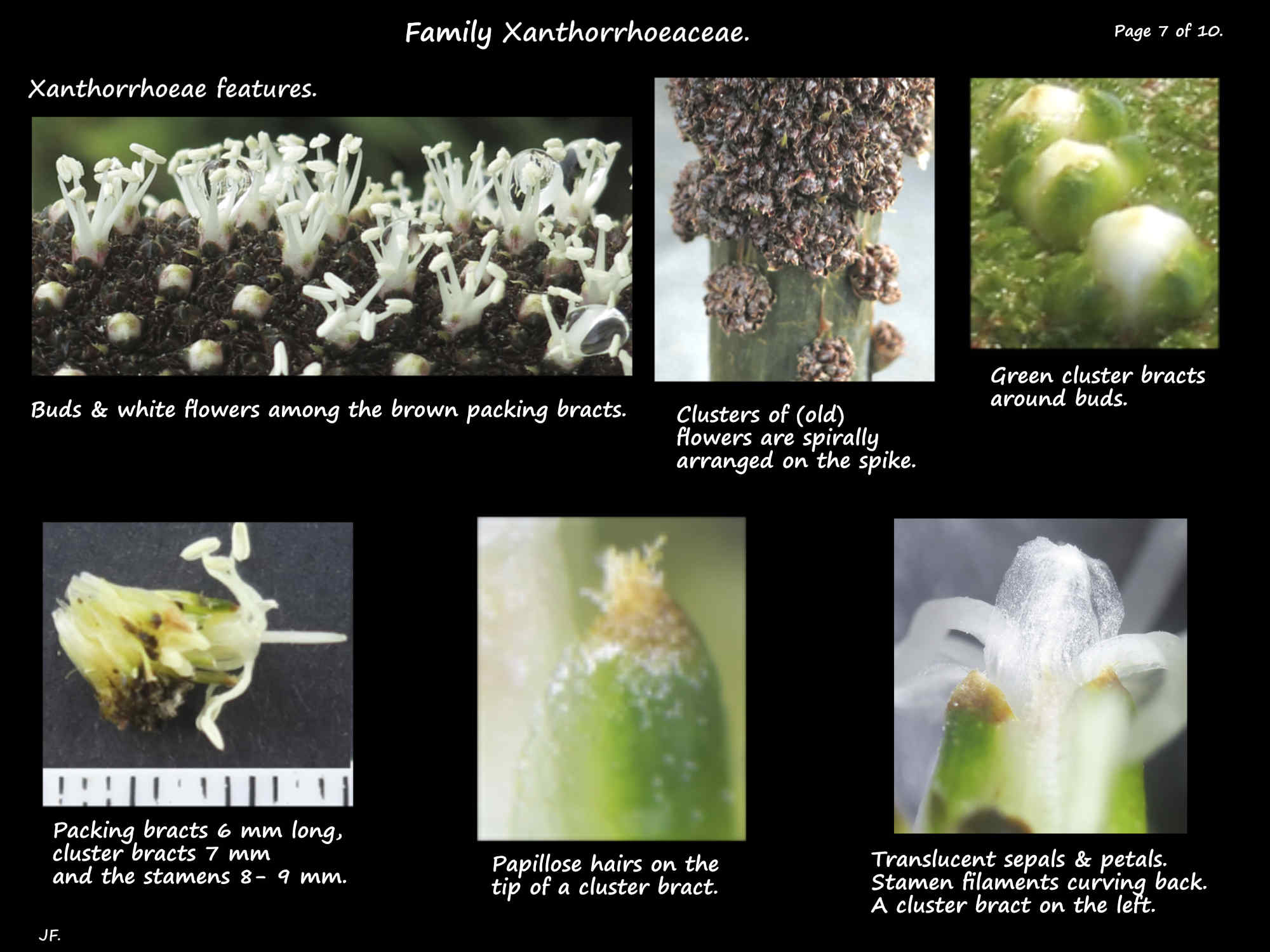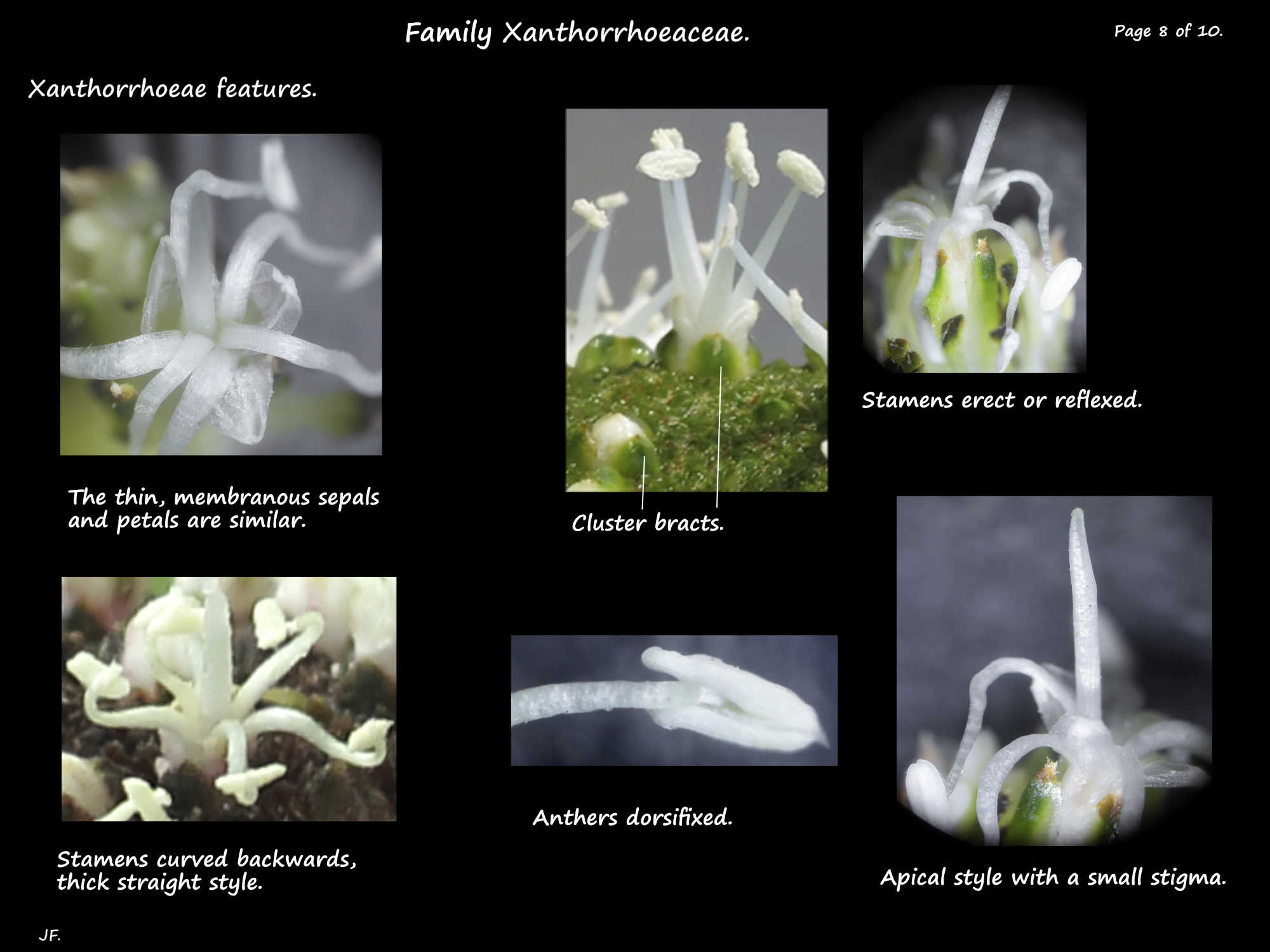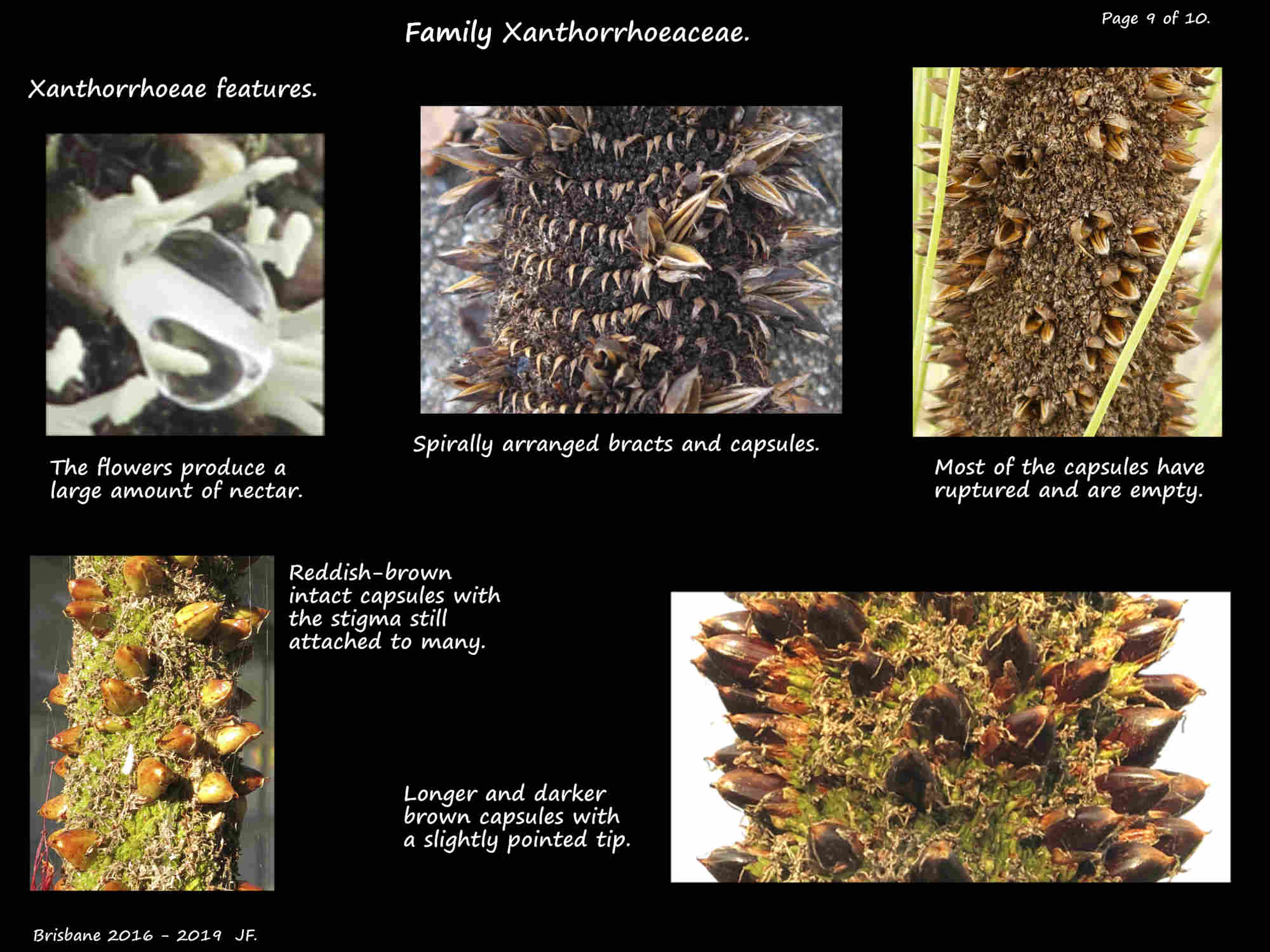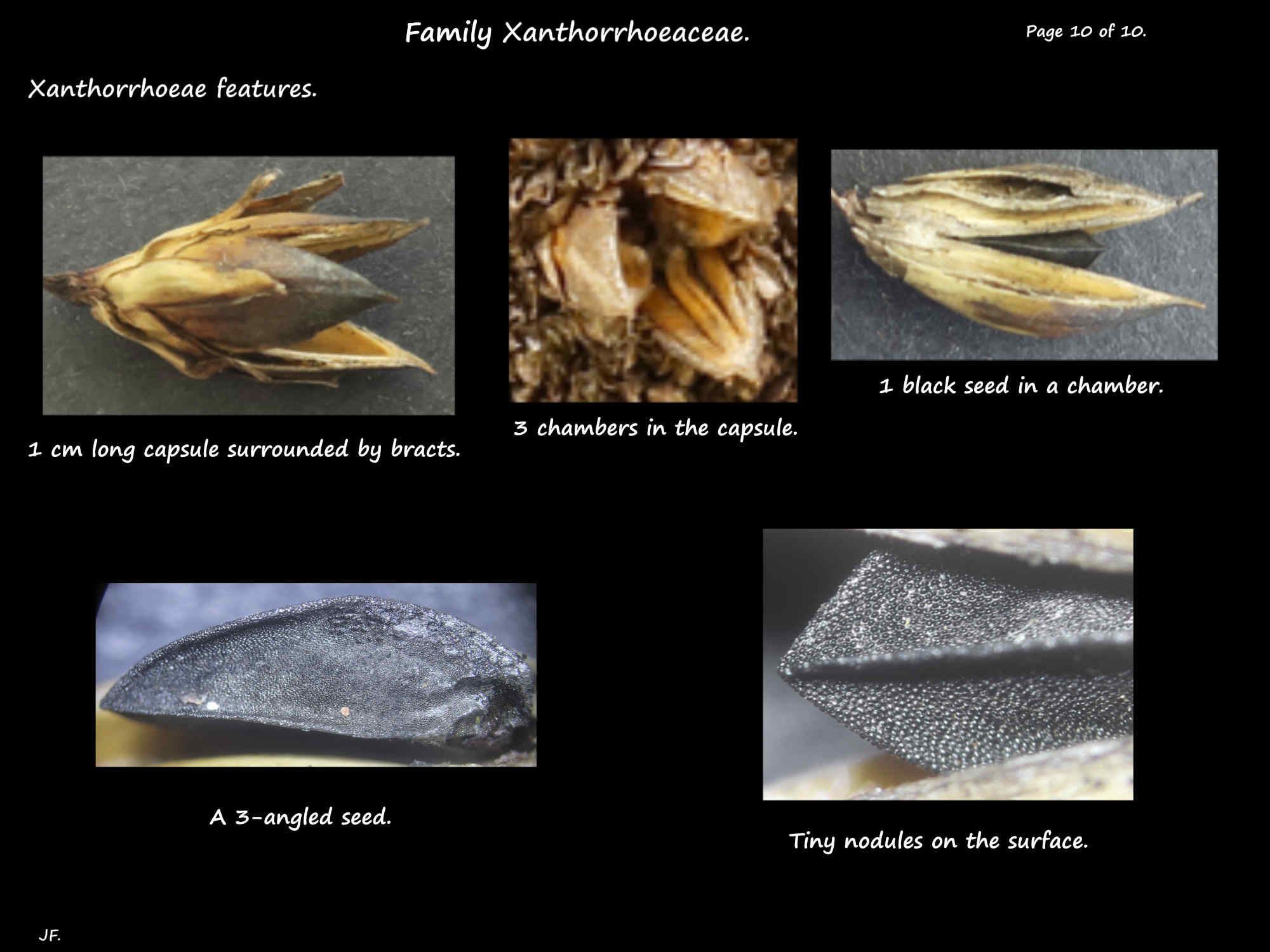Xanthorrhoeae.
Previously in the strictly defined family Xanthorrhoeaceae it is now mostly classified as the
sub-family Xanthorrhoeoideae in the new loosely defined Asphodelaceae s.l.
There are 28 to 30 species of Grass trees or Black boys all endemic to Australia.
Seven species occur in Queensland – X. fulva, X. glauca, X. johnsonii, X. latifolia, X. macronema,
X. minor and X. pumilio.
Plants initially have a dense crown of leaves.
As the leaves die their bases form an underground trunk which later becomes woody.
The trunk may remain underground or, over years or decades it may emerge above ground.
The hollow trunk has aerial roots down the centre and it may branch.
Trunks can be from 10 cm to 5 or 6 m high and after fire they become black.
The rosette of leaves forms a roughly spherical, hemi-spherical or erect crown.
Some plants develop a few crowns.
The closely spaced leaves are alternately arranged in a spiral.
Up to 1.4 m long they have a thick, broad base that sheaths the stem and they taper towards the tip.
Measured in the centre they can be from 1.2 to 12 mm wide and 1 to 2 or 3 mm thick.
The blade, examined in the middle is variously shaped and in transverse section can be rhombic, heart-shaped,
concave or roughly quadrangular.
There are microscopic hairs on the edges and there may be small ridges along the blade.
Leaves can be green, blue-green or greyish and hard or soft.
Old leaves usually hang down protecting the trunk.
Each plant usually has only one inflorescence but occasionally there are a few.
The leafless woody scapes have densely packed flowers in a cylindrical spike-like top.
Scapes can be from 30 cm long up to 2.1 m and the spike can be up to around 2 m.
Inflorescences can be straight or curved and the spike may be at an angle to the scape.
The ratio of the length of the spike to the scape is important in identifying species
e.g. the spike is 1/7 th the length of the scape.
Flowers, without stalks are in clusters that are spirally arranged on the spike axis.
There are always cluster bracts at the base of at least some of the flowers.
The bracts may only be on part of the spike or along the whole length and they can be prominent or obscure.
The spike axis between the flower clusters may be covered in small, variously shaped packing bracts.
These bracts can be broad or narrowly triangular and have long or short pointed tips.
The green or brown bracts can be smooth or have hairs on the surface or edge.
The bisexual flowers have 6 tepals in two whorls of three.
They are somemtimes labelled as sepals and petals.
The 3 sepals are membranous or papery with a narrowed base.
Petals are soft and membranous and can be white, yellow or cream.
Sepals and petals may have a ridge down the outer surface.
They may also have a beak which is a terminal appendage with papillose hairs on the outer surface.
Some sepals and petals in some species may also have a proboscis which is a small projection from the beak.
It always has papillose hairs.
The 6 stamens, on flat filaments are longer than the sepals and petals.
They can be straight or curve backwards.
The dorsifixed anthers open inwards via longitudinal slits.
The superior ovary has 3 locules each with several ovules with axile placentation.
The ovary tapers to an apical style with a simple stigma that may be grooved.
The flowers produce a lot of nectar.
The fruit are straight or curved loculicidal capsules with the style on the blunt or pointed tip.
They extend well past the perianth and the packing bracts.
There are usually 1 or 2 seeds in each chamber.
The roughly ovate seeds are black with a dullish surface.
Flora of Australia Vol. 46 notes that the sizes of the trunk, leaves and inflorescences are variable.
It says that identification requires examination of all features including the length of the spike compared to that
of the scape, the thickness and width of leaves, sepal and petal features etc.
Geographic location and the type of habitat are also very important.
The FOA key on pages 150 to 153 has 37 features, each with 2 choices, which are necessary to differentiate the species.
Plants available in Australia include Xanthorrhoea australis, X. johnsonii and a hybrid of X. glauca.
Many are sold just as a ‘Grass-tree’.
Xanthorrhoea australis.
An Australian native known as the Common or Southern Grass tree.
It is also known as Black boy if the trunk is blacked by fire.
It is widely grown in Australia.
The trunks can be up to 3 m high and are often branched with a few crowns.
The crown initially consists of erect leaves but over time becomes roughly spherical with the old leaves
hanging down around the trunk.
The linear leaves are blue-grey, up to 3 mm wide and around 2 mm thick.
The inflorescence can be from 40 cm long up to 2 or occasionally 3 m.
The spike can be up to 6 times the length of the scape.
The hairless cluster bracts are prominent and the packing bracts also have no hairs.
The sepals have a beak and a proboscis with a hairy tip.
The petals have a proboscis.
The capsules are up to 2 cm long with ovate seeds up to 1 cm long.
Xanthorrhoea glauca.
It is found in N.S.W. and S.E. Queensland but the plants sold are often a hybrid.
The single or branched trunk can eventually grow up to 5 m high.
It can have 1 or many roughly spherical crowns.
The blue-green or blue-grey leaves are up to 1 m long, 5 mm wide and 2.5 mm thick.
The inflorescence scape is 0.5 to 1 m long with a 1 to 2 m high spike.
The slightly hairy, narrowly triangular cluster bracts are visible along the whole spike.
Packing bracts have pointed tips and a beak with some hairs.
The 3 sepals have a beak but no proboscis.
Petals have a proboscis with hairs.
There are 2 sub-species distinguished by the finer details of the leaves and bracts.
Xanthorrhoea johnsonii.
Johnson’s grass tree can develop a trunk up to 5 m high and it usually has only one crown.
The scape is around 2 m long with a slightly longer or shorter spike.
The lower half of the spike has prominent cluster bracts.
All bracts have some hairs.
The features of the sepals are variable and the petals have a proboscis.
J.F.
